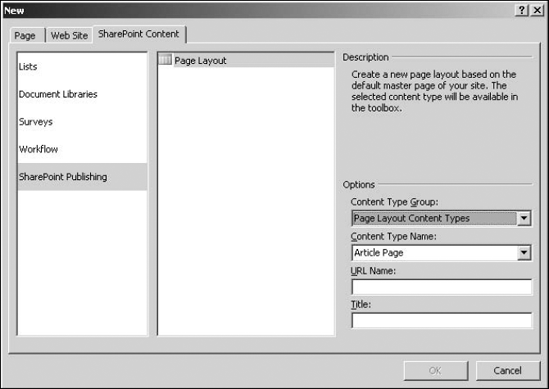13.3. Managing Page Layouts
MOSS introduces a feature called page layouts with the Publishing site template. Page layouts, in essence, are a set of layout pages from which SharePoint site authors can use to create new pages. Like master pages, the page layouts are also stored in the Master Page Gallery of a SharePoint site based on the Publishing site template. As shown in Figure 13.15, you can view the default page layouts available in the Master Page Gallery.
Figure 13.15. The Master Page Gallery of a SharePoint site based on the Publishing site template
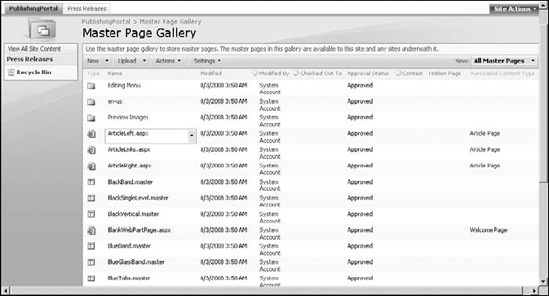
Every page layout is associated with a page layout content type, which defines the columns/fields that can be used to hold metadata associated with a page created by using the page layout. The Site Content Type Gallery, as shown in Figure 13.16, can be used to view the default page layout content types and also create new custom page layout content types based on existing content types.
NOTE
Content Types, introduced in WSS v3 and MOSS, define the nature and behavior of the content that can be stored in items. For example, the Document content type allows for creation of items that can store documents and related metadata. If you have multiple content types associated with a list, you can create items based on these content types and then store them in the list.
This section describes how you can use the page layout feature available in SharePoint publishing Web sites to create Web pages from the SharePoint site interface. Then, I take you through the steps to create custom page layouts by using SharePoint Designer.
Figure 13.16. Page Layout Content Types in the Site Content Type Gallery
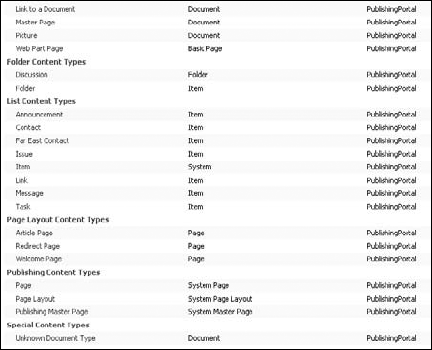
13.3.1. Understanding SharePoint publishing pages
Publishing pages are SharePoint Web pages that are created based on a page layout. SharePoint users with appropriate permissions can create publishing pages either by using the default page layouts available in SharePoint or the custom page layouts created with SharePoint Designer. To create a publishing page in a SharePoint site based on the Publishing site template, follow these steps:
Browse to the SharePoint site based on the Publishing site template.
Choose Site Actions
 Create Page to go to the Create Page Web page in the SharePoint site. This is shown in Figure 13.17.
Create Page to go to the Create Page Web page in the SharePoint site. This is shown in Figure 13.17.Type a title for your publishing page, choose the page layout to be used for creating the publishing page, and then click Create. As shown in Figure 13.18, this creates a publishing page and opens it in the Edit mode in the SharePoint Web site. Based on the layout of the page layout, fields are displayed on the publishing page for modification. For example, Figure 13.18 shows the Title, Page Content, and Rollup Image fields available for modification on the publishing page.
NOTE
These fields are actually columns that are defined in the content type associated with the page layout used to create the publishing page.
When you finish modifying the fields available in the publishing page, you can save the publishing page, start approval workflows, check-in, or perform other operations on the publishing page by using the Page, Workflow, and Tools action menus available in the top-left section of the SharePoint page interface.
By default, the publishing pages are stored in the Pages library of the SharePoint site. You can use this library to view various properties of the publishing pages, such as approval status, check-in/check-out status, workflow status, etc. To access this library, choose Site Actions ![]() View All Site Content and then click the Pages library.
View All Site Content and then click the Pages library.
Figure 13.17. Creating a publishing page in a SharePoint site
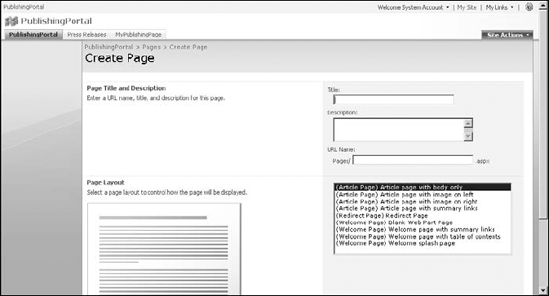
Figure 13.18. The publishing page in a SharePoint Web site
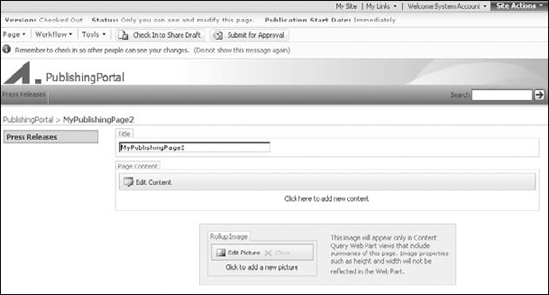
13.3.2. Creating and editing page layouts
SharePoint Designer allows you to create custom page layouts that SharePoint users can later use to create publishing Web pages in the SharePoint site interface. You can either create new page layouts or modify the existing page layouts by using SharePoint Designer.
NOTE
You can't directly modify a publishing page in SharePoint Designer. If you try to do so, SharePoint Designer displays the message shown in Figure 13.19, allowing you to either edit the publishing page in a browser or open the page layout associated with the publishing page in SharePoint Designer for editing.
Figure 13.19. The available options for editing a publishing page in SharePoint Designer

You can follow these steps to create a new page layout by using SharePoint Designer:
Choose File
 New to open the New dialog box. Notice the SharePoint Publishing category in the SharePoint Content tab, as shown in Figure 13.20.
New to open the New dialog box. Notice the SharePoint Publishing category in the SharePoint Content tab, as shown in Figure 13.20.Based on the selection made in the Content Type Group dropdown menu, the associated page layout content types are displayed in the Content Type Name dropdown menu. Choose the page layout content type you want to use for your page layout.
Type the URL name and title of the page layout and then click OK.
The new page layout created by using the previous steps uses the custom master page (site master page) defined for the SharePoint Web site. Once the page layout is created, you can use the SharePoint Designer tools and features to modify the page layout just like any other Web page with a master page attached to it.
NOTE
The SharePoint Designer user interface can't be used to change the custom master page for a specific page layout. The page layouts always inherit the master page settings from the site level.
Figure 13.20. Creating a page layout by using the New dialog box
